In 1998, the Mercedes-Benz SL, R 129 series, provided a glimpse at the future of steering
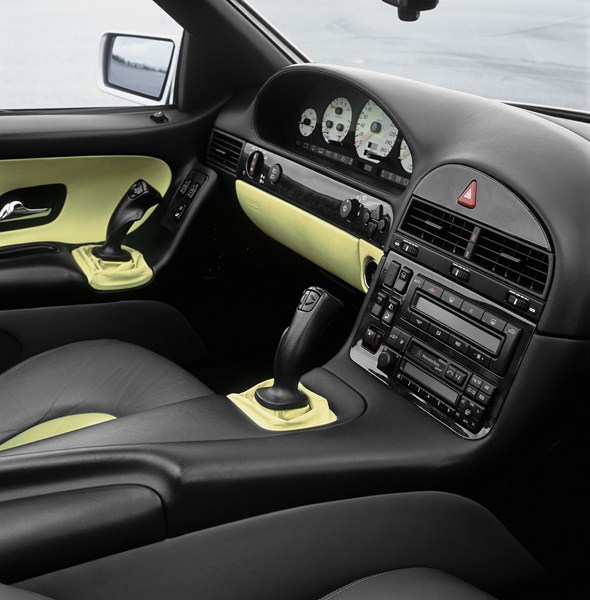

- The research vehicle had side-sticks instead of steering wheel and pedals
- Electromechanical control is safer and faster
- “Drive-by-wire” principle de-couples the input device from the suspension
Stuttgart – In 1998, Mercedes-Benz showed a realistic vision of the future of driving; a vehicle with neither pedals nor steering wheel in the cockpit: a research vehicle based on the R 129 series (1989 to 2001) of the SL model series that was instead controlled by means of side-sticks, in a manner similar to the system used for the first time in the 1996 F 200 Imagination research vehicle.
With these levers, located on either side of the driver on the centre console and in the door panel, it was possible to steer, accelerate, and to brake, as well as indicate a turn. The driver could also use all the functions (including the horn) with a single side-stick, or use both at the same time, as they were electronically connected.
Although at first glance the side-stick might have reminded the observer of a joystick for a games console or computer, the side-stick installed in the research car was no electronic toy but a high-precision device. The vehicle was steered by inclining the grip towards the right or towards the left, whereas pressing it forwards or pulling it back accelerated or slowed down the car.
The indicators and horn were actuated by means of buttons at the upper end of the control stick.
A new interface between driver and car
There was no longer a mechanical connection between the input devices on the one hand and the suspension and engine on the other; instead, all the signals were transmitted electronically. This new type of interface between driver and vehicle (Human-Machine Interface, HMI for short) was made possible by the “drive-by-wire” technology.
This is the name given to the system consisting of sensors and actuators that reads the control signals given by the driver, evaluates them electronically, and then transmits them to the relevant vehicle components.
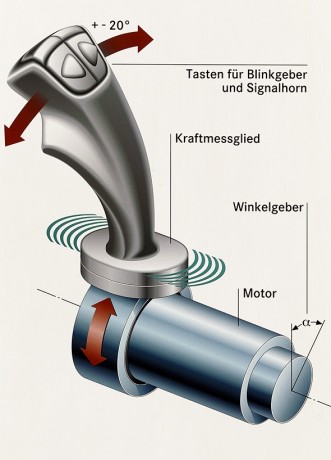
However, it is not only the shape and the location of the side-sticks that distinguishes driving a car equipped with this feature from driving a car with a steering wheel. The way the control signals are technically generated obeys different principles.
For instance, rotation of the steering wheel (usually reduced in a ratio of 1 : 20) is transferred to the turning angle of the wheels on the front axle. This makes very precise steering possible, but requires a large steering angle.
Side-sticks on the other hand only need a steering angle of around 20 degrees to the right or left. These movements are not transferred proportionally to the wheels, because it would not be possible to steer the vehicle reliably – especially at high speeds.
Instead of measuring the deflection of the lever, the system measures the pressure the driver exerts upon the grip. From this measurement the vehicle electronics deduces the steering angle desired by the driver, and this is then transferred by the electronic control device to the steering actuator – at a reduction ratio that depends on the vehicle speed.
At the same time the side-stick has a motor that provides feedback to the driver on the behaviour of the suspension in the form of mechanical resistance, providing a feel for the road conditions.
For the input of acceleration and braking commands, the stick is not moved at all. Instead, force transducers simply measure the force with which the lever is pushed forwards or pulled back. These impulses are also converted by the system into control signals that, in this case, are transferred to the engine and the brakes.
A technical bridge to aviation
The R 129 with side-stick control was the fully operational result of many years of research on driving without steering wheel and pedals at Mercedes-Benz. Projects such as this exclusively electronically – controlled SL are an expression of the consistent will to innovation – and bear witness to the fact that Daimler assumes responsibility for the permanently ongoing development of the car as a cutting-edge mobility system.
This visionary tradition can be traced back to the year 1886, when Carl Benz and Gottlieb Daimler independently invented the motor car, powered by an internal combustion engine.
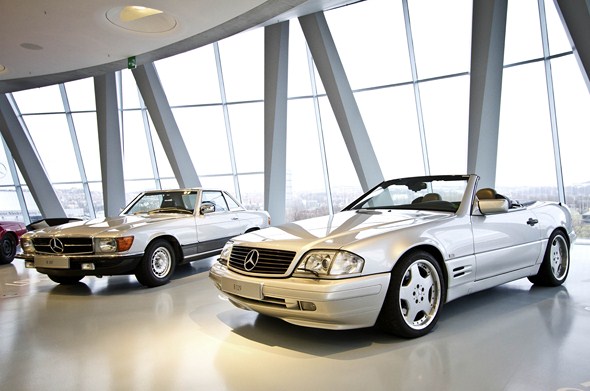
In order to find new, original solutions to the basic requirements of modern society and its infrastructure, it is necessary to think beyond the frontiers of what already exists. And that is precisely what the engineers who developed “drive-by-wire” technology did: they took the technology of advanced aircraft as the model for electronic control.
In this respect, Airbus, for instance, set new standards in the 1980s through the introduction of side-stick control in its commercial aircraft.
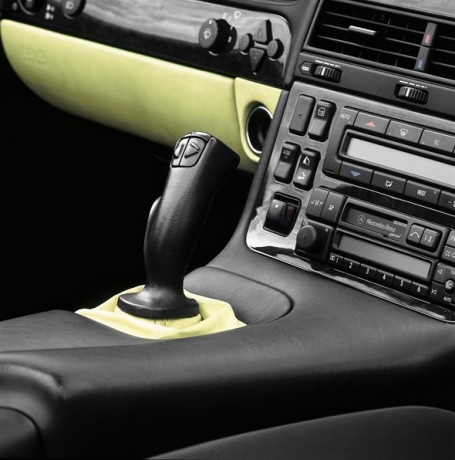
In the research vehicle based on the R 129 series, the system, well-established in aviation, proved itself on the road too. Extensive testing of the system showed several other advantages of “drive-by-wire” control: the new technique proved safer than conventional steering systems and offered ergonomic benefits as well.
Revolutionising the interface between driver and vehicle
In the beginning was the learning effect. In the minds of almost, everyone an automobile is steered by mechanically changing the position of the wheels using a steering instrument. This maxim has held true ever since the invention of the motor car with internal combustion engine by Carl Benz and Gottlieb Daimler in 1886.
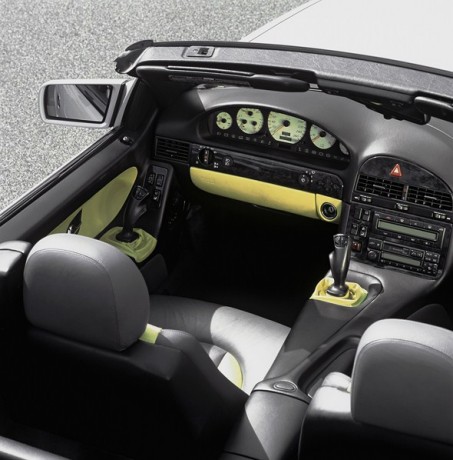
The increasing use of more and more electric and electronic systems in cars did not change this basic principle. The pedals as the established input system for accelerating (fuel) and slowing down (brakes) still belong to the basic equipment of every car. Even advanced electric cars are operated in this manner.
The use of side-sticks to control the vehicle would involve a revolutionary break with a tradition that dates back over 125 years. However, abandoning the use of steering wheel and pedals would have significant benefits, as the research results from the testing of the SL with “drive-by-wire” technology and other similarly equipped Mercedes-Benz test vehicles show.
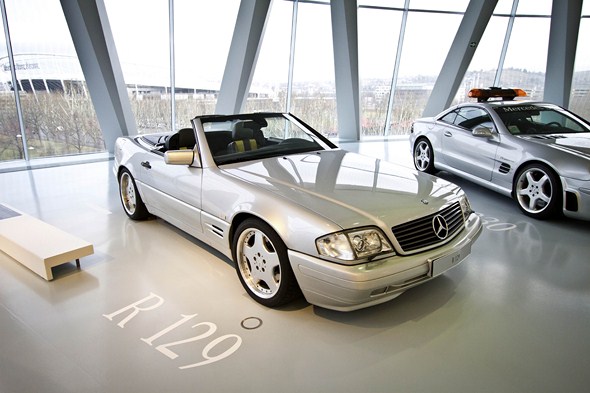
The ergonomic benefits are immediately apparent. The driver has more freedom of movement and a better view of the dashboard instruments. The side-sticks also allow the driver a more comfortable seating position than in conventionally-configured cars: the feet can be placed wherever the driver wants and the arms do not have to be held in a continually extended position with the hands on the steering wheel.
The driver can instead rest his or her arms comfortably on the centre console and door armrests, reducing strain on the shoulder muscles. The seating position can be adjusted and stored electrically.
In the event of an accident, in particular in the case of a head-on collision, the modified interior layout is also beneficial from the aspect of passive safety, as neither pedals nor steering wheel can intrude into the vehicle interior and cause injuries.
Active safety also benefits from the “drive-by-wire” systems, since they can support the driver intelligently when steering, accelerating, and braking, as they not only register control signals, but interpret them as well. In fractions of a second, the computer-based dynamic handling control system calculates the nominal values for a safe handling situation and compares them with the actual values of the control signals produced by the driver.
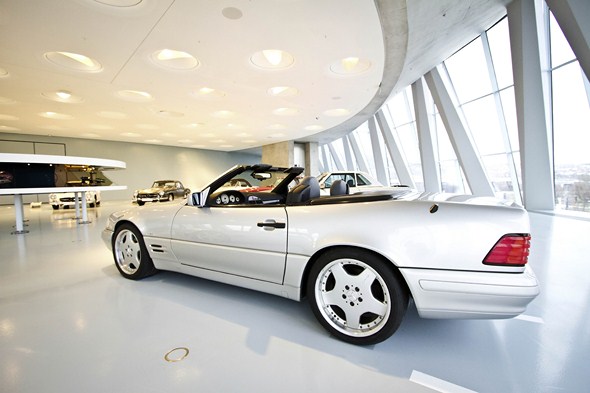
The vehicle electronics then execute the steering, acceleration and braking orders given by the driver in such a manner that the vehicle stays securely on track in even the most critical handling situations.
But even from an exclusively ergonomic standpoint, vehicle control via the little levers proves superior to the steering-wheel-and-pedals ensemble. In sudden emergency braking manoeuvres, the reaction speed of the side-stick vehicles is better than that of conventional cars.
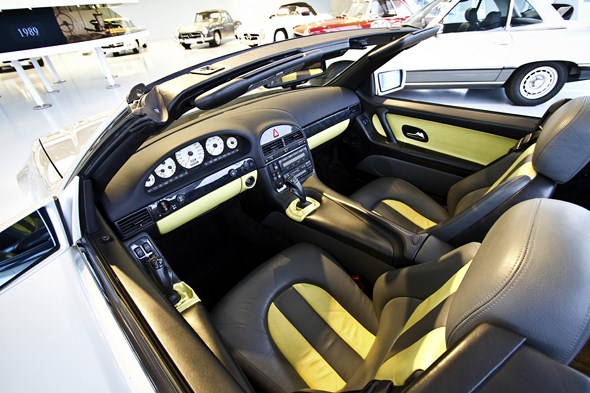
To swiftly change from one pedal to the other, a driver requires – at an average speed of 80 km/h – around 10 metres in addition to the pure braking distance. With “drive-by-wire” on the other hand, the signal for a full-brake application is transmitted virtually instantaneously.
The fact that Mercedes-Benz presented this technology, fully matured and ready for practical use, in an R 129 series SL in 1998 reflects a great tradition – because the SL-Class two-seater open-top sports cars have time and again set new standards for technological innovation.





